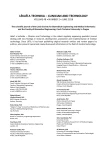Machine learning using speech utterances for parkinson disease detection
Autoři:
Ondřej Klempíř; Radim Krupička
Působiště autorů:
Department of Biomedical Informatics, Faculty of Biomedical Engineering, Czech Technical University in Prague, Kladno, Czech Republic
Vyšlo v časopise:
Lékař a technika - Clinician and Technology No. 2, 2018, 48, 66-71
Kategorie:
Original research
Souhrn
Pathophysiological recordings of patients measured from various testing methods are frequently used in the medical field for determining symptoms as well as for probability prediction for selected diseases. There are numerous symptoms among the Parkinson’s disease (PD) population, however changes in speech and articulation are potentially the most significant biomarker. This article is focused on PD diagnosis classification based on their speech signals using pattern recognition methods (AdaBoost, Bagged trees, Quadratic SVM and k-NN). The dataset investigated in the article consists of 30 PD and 30 healthy controls (HC) individuals voice measurements, with each individual being represented with 2 recordings within the dataset. Training signals for PD and HC underwent an extraction of relatively well-discriminating features relating to energy and spectral speech properties. Model implementations included a 5-fold cross validation. The accuracy of values obtained by employing the models was calculated using a confusion matrix. The average value of the overall accuracy = 82.3% and averaged AUC = 0.88 (min. AUC = 0.86) on the available data.
Keywords:
Parkinson's disease, speech, machine learning, digital biomarker, classification
Zdroje
- Topol, E.: The patient will see you now. The future of medicine is in your hands. Basic Books, New York, 2015. ISBN 978-0-465-04002-5.
- Ali-Eldin, A. M. R., Hafez, E. A.: Towards a universal architecture for disease data models sharing and evaluation. In: 2017 International Symposium on Networks, Computers and Communications (ISNCC), IEEE, (2017), p. 1–6.
- Yavuz, E., Kasapbaşı, M. C, Eyüpoğlu, C., Yazıcı, R.: An epileptic seizure detection system based on cepstral analysis and generalized regression neural network. Biocybernetics and Biomedical Engineering, 2018; vol. 38, no. 2, p. 201–216.
- Zhang, T., Chen, W., Li, M.: Fuzzy distribution entropy and its application in automated seizure detection technique. Biomedical Signal Processing and Control, 2018; vol. 39, p. 360–367.
- Poewe, W., Seppi, K., Tanner, C. M., Halliday, G. M., Brundin, P., Volkmann, J., Schrag, A. E., Lang, A. E.: Parkinson disease. Nat Rev Dis Primers, 2017; 23:17013.
- Duffy, J. R.: Motor Speech Disorders: Substrates, Differential Diagnosis and Management, 3 Edn. Mosby, St. Louis, 2013.
- Postuma, R. B., Lang, A. E., Gagnon, J. F., Pelletier, A., Montplaisir, J. Y.: How does parkinsonism start? Prodromal parkinsonism motor changes in idiopathic REM sleep behaviour disorder, Brain, 2012; vol. 135, p. 1860–1870.
- Hlavnicka, J., Cmejla, R., Tykalova, T., Sonka, K., Ruzicka, E., Rusz, J.: Automated analysis of connected speech reveals early biomarkers of Parkinson’s disease in patients with rapid eye movement sleep behaviour disorder, Sci Rep, 2017; vol. 7, no. 12.
- Rusz, J., Hlavnicka, J., Cmejla, R., Ruzicka, E.: Automatic evaluation of speech rhythm instability and acceleration in dysarthrias associated with basal ganglia dysfunction, Front Bioeng Biotechnol, 2015; vol. 3, no. 104.
- Skodda, S., Schlegel, U.: Speech rate and rhythm in Parkinson’s Disease, Mov Disord, 2008; vol. 23, p. 985–992.
- Skodda, S., Flasskamp, A., Schlegel, U.: Instability of syllable repetition as a model for impaired motor processing: is Parkinson's disease a "rhythm disorder?", J Neural Transm, 2010; vol. 117, p. 605–612.
- Strimbu, K., Tavel, J. A.: What are biomarkers?, Current Opinion in HIV and AIDS, 2010; vol. 5, no. 6, p. 463–466.
- Tsanas, A., Little, M. A., McSharry, P. E., Spielman, J., Ramig, L. O.: Novel Speech Signal Processing Algorithms for High-Accuracy Classification of Parkinson’s Disease, IEEE Transactions on Biomedical Engineering, 2012; vol. 59, no. 5, p. 1264–1271.
- Shahbakhi, M., Far, D. T., Tahami, E.: Speech Analysis for Diagnosis of Parkinson’s Disease Using Genetic Algorithm and Support Vector Machine, Journal of Biomedical Science and Engineering, 2014; vol. 7, no. 4, p. 147–156.
- Zhang, Y. N.: Can a Smartphone Diagnose Parkinson Disease? A Deep Neural Network Method and Telediagnosis System Implementation. Parkinson’s Disease, 2017, p. 1–11.
- Wirth, R.: CRISP-DM: Towards a standard process model for data mining. In: Proceedings of the 4th international conference on the practical applications of knowledge discovery and data mining, Citeseer, (2000), p. 29–39.
- https://www.mathworks.com/matlabcentral/fileexchange/19236-some-basic-audio-features [cit. 15. 3. 2017].
- https://www.mathworks.com/matlabcentral/fileexchange/45831-matlab-audio-analysis-library?focused=3812573&tab=function [cit. 15. 3. 2017].
- Khouli, R. H. E., Katarzyna, K. J., Barker, P. B., Habba, M. R. Jacobs, M. A., Bluemke, D. A.: The Relationship of Temporal Resolution to Diagnostic Performance for Dynamic Contrast Enhanced (DCE) MRI of the Breast, J Magn Reson Imaging, 2009; vol. 30, no. 5, p. 999–1004.
- Geeta, Y.: Prediction of Parkinson's disease using data mining methods: A comparative analysis of tree, statistical and support vector machine classifiers. In: Computing and Communication Systems (NCCCS), 2012 National Conference on Computing and Communication Systems, IEEE, (2012), p. 1–8.
Štítky
BiomedicínaČlánok vyšiel v časopise
Lékař a technika

2018 Číslo 2
Najčítanejšie v tomto čísle
- Application of sibgle wireless holter to simultaneous EMG, MMG and eim measurement of human muscles activity
- Response by an automated inspired oxygen control system to hypoxemic episodes: assessment of damping
- Workflow for bioprinting of cell-ladem bioink
- Machine learning using speech utterances for parkinson disease detection
